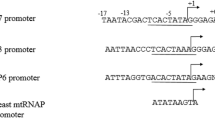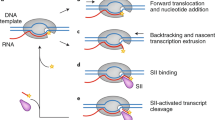Abstract
Faithful and efficient transcription initiation at the mouse ribosomal gene promoter requires besides RNA polymerase I (pol I) four polypeptide trans-acting factors, termed TIF-IA, TIF-IB, TIF-IC, and mUBF. We have partially purified these proteins from cultured Ehrlich ascites cells and show that in the presence of TIF-IA and TIF-IB, pol I directs very low amounts of specific transcripts. Neither TIF-IC nor mUBF on their own significantly stimulate the efficiency of template utilization. However, both factors together strongly activate transcription. Interestingly, factor TIF-IB — the murine homologue of human SL1 — fails to program a human extract to transcribe the murine template, but requires its homologous RNA polymerase I. This finding implicates that not only some rDNA transcription factors but also pol I exhibits species-specific differences. The growth-related factor TIF-IA, on the other hand, stimulates both mouse and human rDNA transcription. This regulatory factor whose amount or activity fluctuates according to the proliferation rate of the cells, is functionally inactivated by antibodies against cdc2 protein kinase. This result together with the observation that transcription is stimulated by ATP-γS, an ATP analogue which is a substrate for protein kinases but not for protein phosphatases, strongly suggests that post-translational protein modification is involved in rDNA transcription regulation.
Similar content being viewed by others
References
Moss T, Michelson K, De Winter R: The promotion of ribosomal transcription in eukaryotes. Oxford Surveys on Eukaryotic Genes 2: 207–250, 1985
Grummt I: Mammalian ribosomal gene transcription. In: Nucleic Acids & Molecular Biology, ed. by F. Eckstein and D.M.J. Lilley, Springer-Verlag Berlin Heidelberg, Vol 3, p. 148–163, 1989
Clos J, Buttgereit D, Grummt I: A purified transcription factor (TIF-IB) binds to essential sequences of the mouse rDNA promoter. Proc Natl Acad Sci USA 83: 604–608, 1986
Schnapp A, Hadelt W, Clos J, Schreck R, Cvekl A, Grummt I: Isolation and functional characterization of TIF-IB, a factor that confers promoter specificity to mouse RNA polymerase I. Nucl Acids Res 18: 1385–1393, 1990a
Bell SP, Learned M, Jantzen HM, Tjian RT: Functional cooperativity between transcription factors UBF1 and SL1 mediates human ribosomal RNA synthesis. Science 241: 1192–1197, 1988
Bell SP, Pikaard CS, Reeder RH, Tjian RT: Molecular mechanisms governing species-specific transcription of ribosomal RNA. Cell 59: 489–497, 1989
Pikaard CS, McStay B, Schultz MC, Bell SP, Reeder RH: The Xenopus ribosomal gen enhancers bind an essential polymerase I transcription factor, xUBF. Genes Dev 3: 1779–1788, 1989
Buttgereit D, Pflugfelder G, Grummt I: Growth-dependent regulation of rRNA synthesis is mediated by a transcription initiation factor (TIF-IA). Nucl Acids Res 13: 8165–8170, 1985
Schnapp A, Pfleiderer C, Rosenbauer H, Grummt I: A growth dependent transcription initiation factor (TIF-IA) interacting with RNA polymerase I regulates mouse ribosomal RNA synthesis. EMBO J 9: 2857–2863, 1990b
Jantzen H-M, Admon A, Bell SP, Tjian R: Nucleolar transcription factor hUBF contains a DNA-binding motif with homology to HMG proteins. Nature 344: 830–836, 1990
Grummt I: Specific transcription of mouse ribosomal DNA in a cell-free system that mimics control in vivo. Proc Natl Acad Sci USA 78: 727–731, 1981
Tower J, Sollner-Webb B: Transcription of mouse rDNA is regulated by an activated subform of RNA polymerase I. Cell 50: 873–883, 1987
Grummt I, Roth E, Paule M: Ribosomal transcription in vitro is species-specific. Nature 296: 173–174, 1982
Learned RM, Cordes S, Tjian RT: Purification and characterization of a transcription factor that confers promoter specificity to human RNA polymerase I. Mol Cell Biol 5: 1358–1369, 1985
Sorger PK, Pelham HRB: Yeast heat shock factor is an essential DNA-binding protein that exhibits temperaturedependent phosphorylation. Cell 54: 855–864, 1988
Prywes R, Dutta A, Cromlish JA, Roeder RG: Phosphorylation of serum response factor, a factor that binds to the serum response element of the c-Fos enhancer. Proc Natl Acad Sci 85: 7206–7210, 1988
Bagchi S, Raychaudhuri P, Nevins JR: Phosphorylation-dependent activation of the adenovirus inducible E2F transcription factor in a cell-free system. Proc Natl Acad Sci 12: 4352–4356, 1989
Jackson SP, Tjian RT: O-glycosylation of eukaryotic transcription factors: implications for mechanisms of transcription regulation. Cell 55: 125–133, 1988
Lichtensteiner S, Schibler U: A glycosylated liver-specific transcription factor stimulates transcription of the albumin gene. Cell 57: 1179–1187, 1989
Edelman A: Protein serine/threonine kinases. Ann Rev Biochem 57: 567–613, 1987
Reed SI, Hadwinger JA, Lörincz AT: Protein kinase activity associated with the product of the yeast cell-cycle gene CDC28. Proc Natl Acad Sci USA 82: 4055–4059, 1985
Gautier J, Norbury C, Lohka M, Nurse P, Maller J: Purified maturation-promoting factor contains the product of a Xenopus homolog of the fission yeast cell cycle control gene cdc2 +. Cell 54: 433–439, 1988
Draetta G, Beach D: Activation of cdc2 protein kinase during mitosis in human cells: cell-cycle dependent phosphorylation and subunit rearrangement. Cell 54: 17–26, 1988
Draetta G, Brizuela L, Patashkin J, Beach D: Identification of p34 and p13, human homologs of the cell cycle regulators of fission yeast encoded by cdc2+ and sucl+. Cell 50: 319–325, 1987
Draetta G, Luca F, Westendorf J, Brizuela L, Ruderman J, Beach D: cdc2 protein kinase is complexed with both Cyclin A and B: evidence for proteolytic inactivation of MPF. Cell 56: 829–838, 1989
Brizuela L, Draetta G, Beach D: Activation of human CDC2 protein as a histone H1 kinase is associated with complex formation with the p62 subunit. Proc Natl Acad Sci USA 86: 4362–4366, 1989
Giordano A, Whyte P, Harlow E, Franza BR, Beach D, Draetta G: A 60 kd cdc2 associated polypeptide complexes with the EIA proteins in adenovirus-infected cells. Cell 58: 981–990, 1989
Smith SD, Oriahi E, Lowe D, Yang-Yen H-F, O'Mahony D, Rose K, Chen K, Rothblum LI: Characterisation of factors that direct transcription of rat ribosomal DNA. Mol Cell Biol 6: 3105–3116, 1990
Mishima Y, Financsek I, Kominami R, Marumatsu R: Fractionation and reconstitution of factors required for accurate transcription of mammalian ribosomal RNA genes: identification of a species-dependent initiation factor. Nucl Acids Res 10: 6659–6669, 1982
Tower J, Cizewski-Culotta V, Sollner-Webb B: Factors and nucleotide sequences that direct ribosomal DNA transcription and their relationship to the stable transcription complex. Mol Cell Biol 6: 3451–3462, 1986
Grummt I, Maier U, Ohrlein A, Hassouna N, Bachellerie J.P: Transcription of mouse rDNA terminates downstream of the Yend of 28S RNA and involves the interaction of factors with repeated sequences in the 3′ spacer. Cell 43, 801–810, 1985
Grummt I, Rosenbauer H, Niedermeyer I, Maier U, Ohrlein A: A repeated 18 by sequence motif in the mouse rDNA spacer mediates binding of a nuclear factor and transcription termination. Cell 45, 837–846, 1986
Bartsch I, Schoneberg C, Grummt I: Evolutionary changes of sequences and factors that direct transcription termination of human and mouse ribosomal genes. Mol Cell Biol 7: 2521–2529, 1987
Author information
Authors and Affiliations
Rights and permissions
About this article
Cite this article
Schnapp, A., Rosenbauer, H. & Grummt, I. Trans-acting factors involved in species-specificity and control of mouse ribosomal gene transcription. Mol Cell Biochem 104, 137–147 (1991). https://doi.org/10.1007/BF00229813
Issue Date:
DOI: https://doi.org/10.1007/BF00229813




